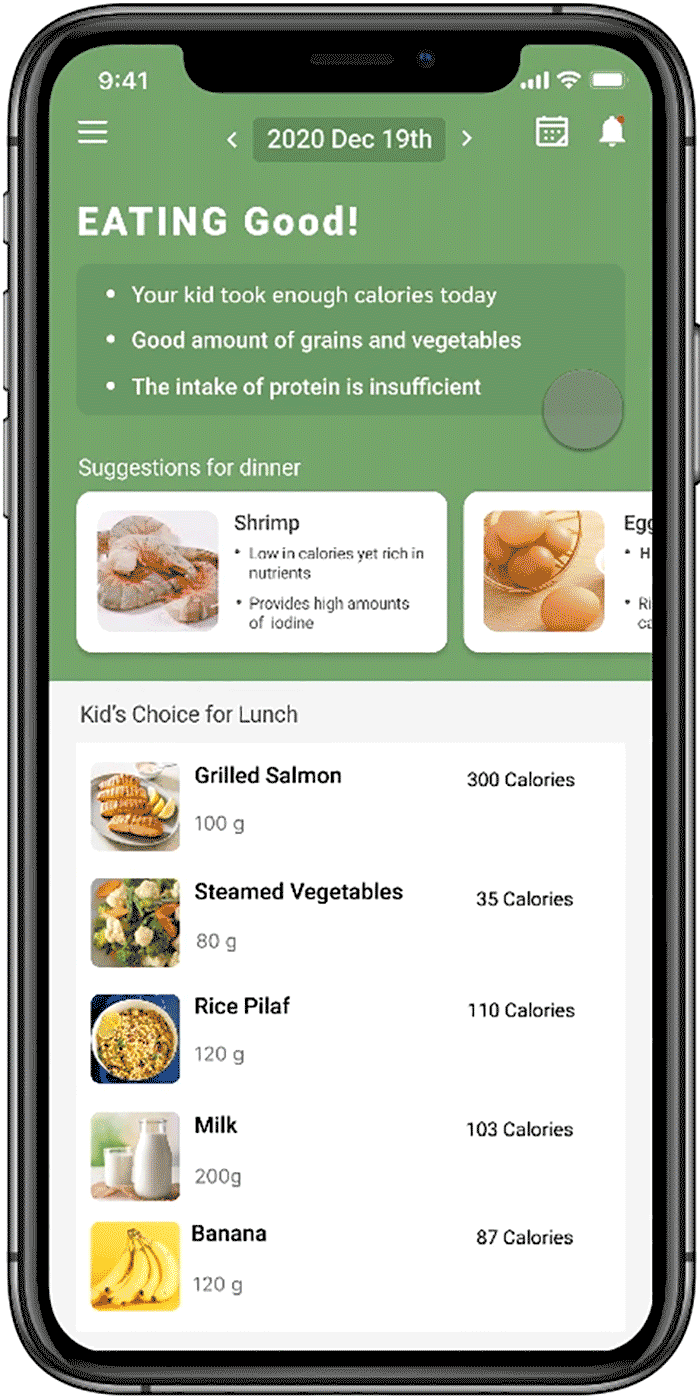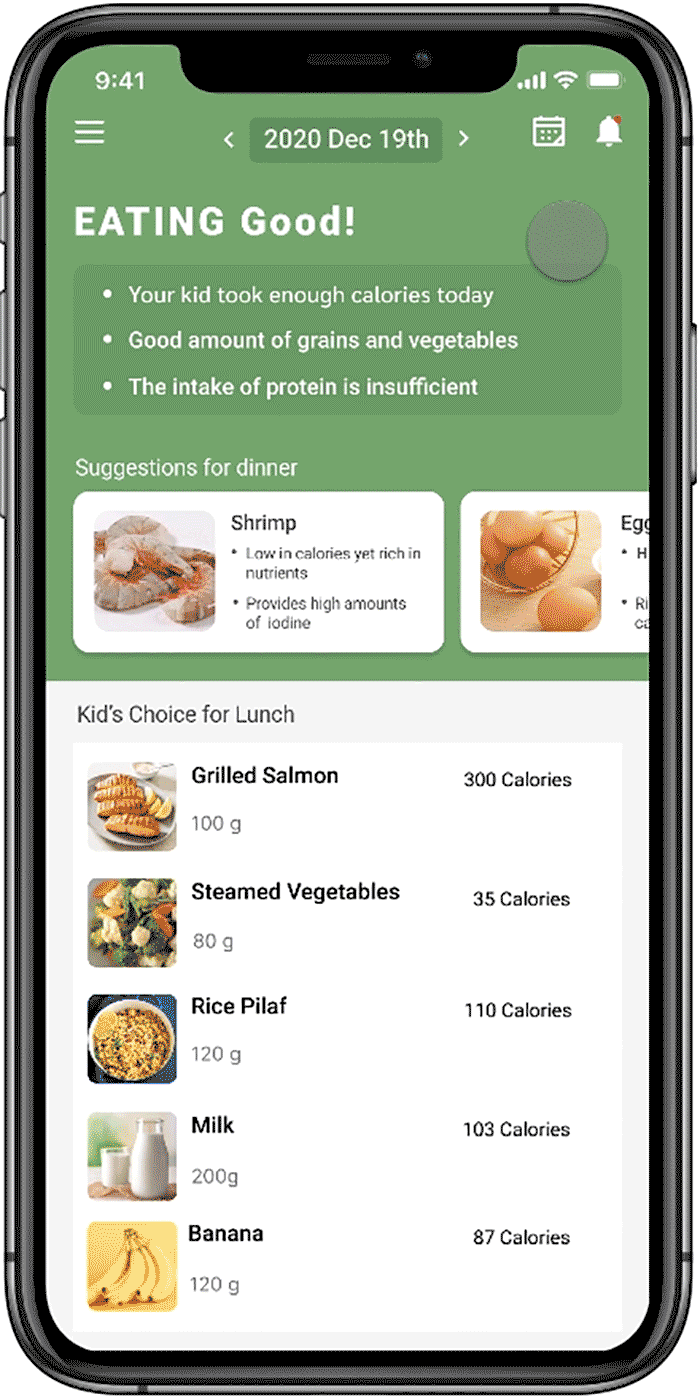
FOOD TRACKER
Track Kid’s Lunch At School
CHALLENGE
Provide a platform for parents to get information about their kid’s school meals anytime, anywhere, so that they will have a better understanding of their kid’s nutrition balance and know how to prepare their dinner after school.
DURATION
4 Weeks
TEAM
Watson Wang, and Felix
MY ROLE
Secondary research
User interview
Persona
Workflow
Ideation
Prototyping
Usability testing
Visual design
TOOLS
Figma, InVision, Adobe Creative Suite
PROJECT BACKGROUND

Healthy Diet Education
Based on information from the Centers for Disease Control and Prevention (CDC), Schools are in a unique position to provide students with opportunities to learn about and practice healthy eating behaviors. Eating healthily could improve cognitive function in children and adolescents, which is important for learning.

Kids’ Bad Eating Habits
Empty calories from added sugars and solid fats contribute to 40% of daily calories for children and adolescents aged 2–18 years—affecting the overall quality of their diets.
Many children like eating junk food, and let their children eat healthy vegetables is a task imposed by parents. Moreover, Some parents don’t know that their children are already overweight or malnutrition.

Government Guidance
Since 2011, Michelle Obama and Hunger-Free Kids Act have tried to transform the food pyramid recommendation into 'MyPlate'.
USDA's child nutrition programs help kids promote health and educational readiness. These programs are administered by USDA's Food and Nutrition Service, with a total cost of more than $23 billion in the fiscal year 2019.
DESIGN CHALLENGE
How to better understand kids' nutrition balance at school,
and know how to prepare their dinner after school?
DESIGN SOLUTIONS


1. What and how well the kid ate at
school today.
Daily lunch info of kid. What food kids ate, how much nutrition was provided, and the MyPlate system. Also, give parents advice on which food can help their kid get enough nutrition for today.

2. Suggestions for dinner
Check the suggested ingredients for dinner.
Ingredients description, Nutrition Facts

3. Calendar
Check how the kid eats this month. And quick access to the daily report for each day.

4. Weekly Report
The weekly report summarizes how well the kid ate this week and the food they like. It helps parents decide their shopping list.

5. Badges
Check the Badges achieved and the kid’s favorite food.
DESIGN PROCESS
RESEARCH
CURRENT CATERING PATTERN
Based on both online research and survey, I find that most children eat lunch at school, and the current catering system mainly consists of two patterns: self-selecting model and lunchbox model.
Catering Pattern at School
Brief intro
Pay methods
How to know?
Good points
Pain points
Lunchbox
School provide lunch box and kids have no choice
Paid intuition
Have an online menu. But kids may not eat the food
At least parents can know the menu
If food is not what they like, they will not eat
Self-selecting
Kids select food from different kinds of food
Paid intuition, pay by card
Ask children and teachers
Children can choose what they like to eat.
Parents hardly know what children choose to eat
DEFINE USERS AND STAKEHOLDERS
After secondary research and initial interviews with parents, we found that parents are the ones who care most about their children’s balanced nutrition and they take a lot of effort to track what their children eat and help form good eating habits for their children.
Target users: Parents
Parents who have kids (age: 6-13), who have breakfast or lunch in school.
Stakeholders: School, Kids
User goal: Provide a healthy food tracker for parents of kids so that they can have a better understanding of what food and nutrition their children have taken in school and in after-school time supply the corresponding nutrition to ensure that the child has balanced nutrition.
SURVEY RESULTS
User interviews were conducted to understand parents’ user journey and pain points when they try to track what their kids eat at school and try to help their kids form a good eating habits.

PERSONA


COMPETITOR ANALYSIS

NUTRITION STANDARD RESEARCH

My Plate
1. Adequate protein intake
2. Low sugar and salt intake
3. Milk should be 1% low-fat
4. Whole grain-comprised cereal
5. Vegetables-fruit plate

By Gender & Age
To get a better understanding of domain knowledge in nutrition, I did research and find details of requirements from Myplate and different nutrition intake standards by children’s age and gender.
IDEATION
WORK FLOW

STORY BOARD
SKETCH UI

PROTOTYPE
LOW-FI PPROTOTYPE

USABILITY TEST

TASK 1 - Home Page
TASK 2 - Meal Page
TASK 3 - Report Page
TASK 4 - Summary Page
Imagine it’s after lunchtime and you attain a notification from the mobile app.
Check it and review the home page to check what your kid just ate.
Choose the food you want to look into from your kid’s food order list.
Try to evaluate your kid’s nutrition balance based on MyPlate and nutrition info.
Shift to the report page and have a look at the whole picture of your kid’s health
Pay attention to highlights and warnings to check the special points.
Finally, click the summary page to overview all the achievements your kid got
Have a look at all your kid’s favorite food and think whether they’re accurate.
ITERATION
1. Home Page
“ Ring chart is not useful. But I just want to find the core problem.”
“ There is too much text in MyPlate.”
“ Need more ingredient suggestion instead of meal suggestion from food suggestion section.”

old version

old version

new version

new version
2. Meal Page
“ I want to see the nutrition facts instead of all certain amount of ingredients.”
“ Myplate is not useful for me.”
“ I can not understand nutrition analysis percentage.”

old version

new version

new version
3. Calendar
“ Good to have the calendar, but I care more about a period summary and weekly report.“
“ Emotions are cute, but they sometimes discourage me to check the date. A small point might be better.“
“ The records for Saturday and Sunday are confusing.“

old version

old version

new version
4. Summary
“ It’s better to see all achievements.“
“ It’s useful to have a summary of all achievements. But kids are more interested in games and they need rewards for motivation.”

old version

new version
DESIGN SOLUTIONS
USER FLOW

MEASURE SUCCESS
In the last round of usability testing, 5 users were tested with evaluation and feedback. The result indicates the App will be helpful for parents.
“Too complex.”
“Acceptable.”
“It will be very helpful.”
Great! Can’t wait!
“ I want to use it!”
FORESIGHT THINKING

1. Statics Feedback for School
Sales and student data provided for the school will help the school limit unhealthy food, adjust unpopular food, and better understand the situation of each student.
2. Gamification to motivate kids to eat healthily
- Food ‘Digimon‘
After finishing the first step to help children eat healthily is to let their parents know kids’ eating conditions. The next step is to motivate children themselves to form good eating habits.
This ‘Food Virtual Animals’ system provides cartoon characters for children each month, and children can give them an upgrade using points they earn for eating healthily. Therefore, the characters will evolve and change their look after a certain level. As a result, this new function will motivate children to eat healthily as well as bring up more topics about healthy food in school.
